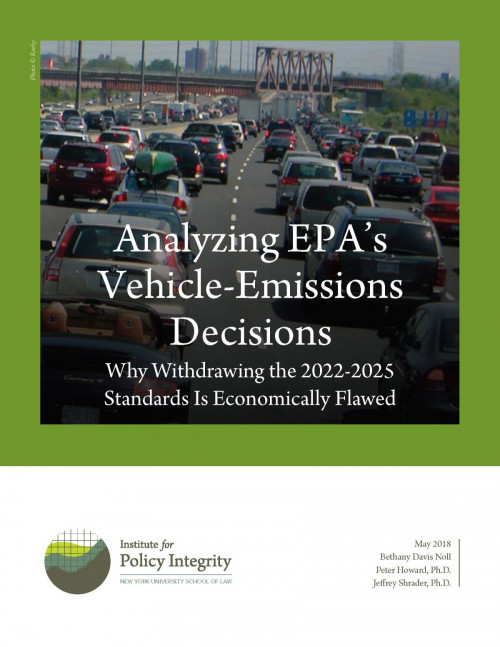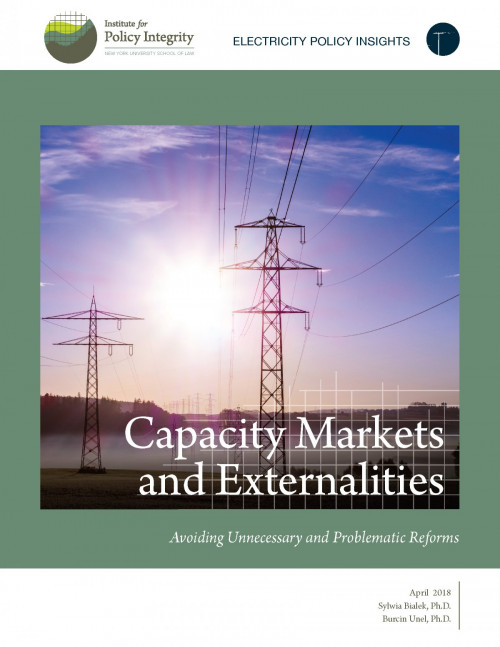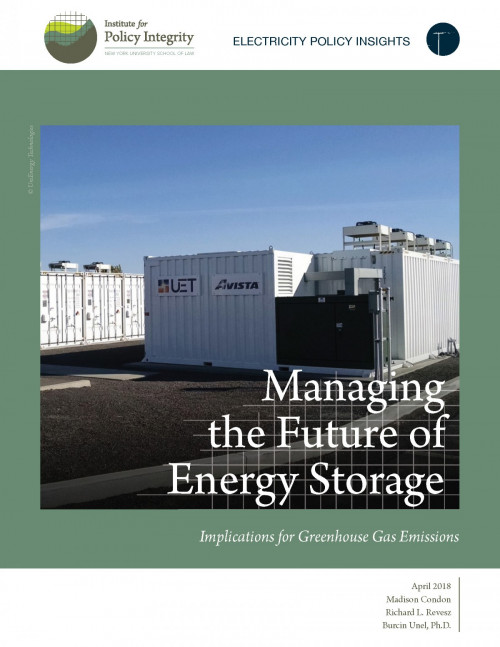-
Comments to NHTSA on Civil Penalties for Violating Fuel Economy Standards
In December 2016, pursuant to the Inflation Adjustment Act of 2015, the National Highway Traffic Safety Administration (NHTSA) finalized a rule that adjusted civil penalties for car manufacturers that violate fuel economy standards, in order to line them up better with inflation. That rule put the penalties at $14 per tenth of a mile per gallon. NHTSA is now proposing a new rule to lower the penalties from $14 per tenth of a mile per gallon back to the previous rate of $5.50 per tenth of a mile per gallon, claiming that the $14 penalty would have a significant negative economic impact. Our May 2018 comments argue that NHTSA should explain why it is justified in reducing the penalty from $14 to $5.50 and consider the forgone benefits when considering whether the civil penalties will have a “negative economic impact.” Because NHTSA has not provided this explanation, the proposed reduction is arbitrary and capricious.
-

Analyzing EPA’s Vehicle-Emissions Decisions
Why Withdrawing the 2022-2025 Standards Is Economically Flawed
The Environmental Protection Agency sets greenhouse gas emissions standards for cars and light trucks, and it periodically reevaluates these standards to make sure that car manufacturers can comply. In April 2018, EPA withdrew its previous determination that standards for model year 2022–2025 vehicles were appropriate and would improve public welfare, now saying that more recent information suggests that the standards are too stringent. Our policy brief shows that EPA’s claim—that new information indicates that the assumptions underlying the previous determination are unrealistic—is not supported by the evidence. In fact, the opposite is the case. Recent trends in fuel prices, vehicle sales, automaker compliance, and safety all indicate that the existing 2022–2025 standards can be met at low cost while delivering large benefits to consumers and the economy. EPA’s decision to withdraw the standards will instead cause regulatory uncertainty that will hurt the automotive sector while also harming the environment.
-
Comments to EPA on Coal Combustion Residuals Rule
In 2015, the United States Environmental Protection Agency (EPA) established minimum criteria for the safe disposal of coal combustion residuals. At the time, EPA projected that the new rule would yield substantial health and environmental benefits. EPA now proposes to weaken the requirements of the 2015 rule but insists that doing so “will not change risks to human health and the environment” and thus will have no effect on the projected benefits of the 2015 rule. Our comments explain why EPA cannot reasonably assume that its proposed changes will have no effect on the 2015 rule’s projected benefits.
-

Capacity Markets and Externalities
Avoiding Unnecessary and Problematic Reforms
Many states are taking action on climate change by paying zero- and low-emitting electricity generators for avoiding the emissions that fossil-fuel-fired resources would otherwise emit. These “externality payments” help level the playing field between emitting and non-emitting generators. Critics of these policies argue that these payments might negatively affect the efficiency of wholesale electricity markets by reducing capacity prices, which heavily affect how generators enter and exit the market. Our report shows why the premises underlying recent reforms, which seek to shield capacity markets from the potential price impact of pollution externality payments, are flawed.
-
Comments on Proposed Repeal of the Clean Power Plan
As the Environmental Protection Agency (EPA) continues its rulemaking to repeal the Clean Power Plan, we submitted two sets of comments that challenge EPA’s legal and economic arguments for undoing this important climate policy.
-

Managing the Future of Energy Storage
Implications for Greenhouse Gas Emissions
Many policymakers assume that increasing deployment of energy storage will automatically reduce greenhouse gas emissions, in part by helping to integrate renewable energy resources with intermittent and variable generation. This report, published in the Harvard Environmental Law Review, explores situations in which energy storage systems can in fact lead to increased emissions, and offers reforms to correct for poor incentives while ensuring that energy storage can provide the maximum benefit possible to the grid.
-
Comments on the Rescission of BLM’s Waste Prevention Rule
The Bureau of Land Management has proposed to rescind or revise its 2016 rule to limit methane emissions associated with natural gas production. The analysis for the original rule showed it to be hugely beneficial to the public, largely due to the avoided climate damages, for which BLM relied on the IWG’s Social Cost of Methane in the original analysis. Now, BLM has radically altered the analysis for the rule, claiming that the costs outweigh its benefits and the Bureau is justifying its decision to rescind or revise the rule based on this flawed rehashing of the effects, even though many of the problematic elements actually undercut BLM’s justification of the proposal to rescind or revise the rule. We submitted comments focused on this faulty analysis and also submitted joint comments on how BLM failed to appropriately value the Social Cost of Methane and other foregone benefits that would result from the rule’s rescission.
-
Comments on EPA’s Failure to Monetize Forgone Emission Reductions in CTG Withdrawal
EPA is soliciting comments on the proposed withdrawal of its control techniques guidelines (CTG) for the oil and natural gas industry. EPA supports its proposed withdrawal of the CTG with an analytical memorandum on avoided costs and forgone emission reductions. The agency monetizes the alleged avoided costs down to the dollar, but EPA fails to monetize the forgone emission reductions. Our joint comments illustrate how the proposed withdrawal’s costs outweigh its benefits, by applying the Social Cost of Methane to EPA’s quantified foregone emissions reductions. We argue that by only quantifying the volume of forgone methane reductions, instead of monetizing the associated damages to the environment, public health, and welfare, EPA obscures the very real and readily monetizable negative consequences of its proposed withdrawal.
-
Comments to OSMRE on Failure to Use the Social Cost of Greenhouse Gases in a Federal Mining Plan
We recently submitted comments to Office of Surfacing Mining Reclamation and Enforcement (OSM) on its environmental assessment (EA) on modifying the federal mining plan for Bull Mountains Mine No. 1 in Montana. The EA evaluates a proposal to extend operations at an existing mine by nine years, which would produce an extra 86.7 million tons of coal. While the EA quantifies the tons of greenhouse gas emissions related to the project, OSM refused to use the social cost of greenhouse gases metric to monetize the climate effects of these emissions. Our comments explain why the agency’s refusal is arbitrary and unlawful in light of a growing body of case law, which holds that failure to monetize a project’s costs is impermissible if an agency justifies an action based on the project’s monetized benefits. Our comments also explain why the social cost of greenhouse gases metric is appropriate for projects of this scale, why the metric’s use is not limited to rulemakings, and how failing to adequately account for the project’s climate effects is a violation of NEPA.
-
Comments to FERC on Failure to Monetize Climate Effects of Riverdale Gas Pipeline
We recently submitted comments to the Federal Energy Regulatory Commission on its environmental assessment (EA) for the Rivervale South to Market pipeline project in New Jersey. Once again, FERC quantified the tons of downstream greenhouse gas emissions that the project would generate, but the Commission did not use the social cost of greenhouse gases to monetize the climate effects of those emissions. In the EA, FERC incorrectly claims that it is impossible to determine the significance of a discrete amount of additional greenhouse gas emissions. Our comments dispel FERC’s arbitrary and misleading rationale and explain why failing to meaningfully analyze a project’s climate effects violates NEPA. Our comments also offer guidance for how the Commission should use the social cost of greenhouse gases metric based on the best available science and economics going forward.



